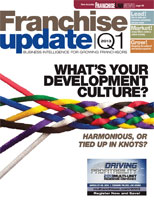Border Crossing: Navigating the Waters of International Expansion
Different types of international franchises are being granted today for U.S.-based education, food and beverage, retail, and service franchises. The level of franchisor investment and control for each type of franchise varies. How do you know which method to use when expanding internationally? Master franchises, area developers, company-owned stores, or joint ventures? We look at the five types in use today and the pluses and minuses of each.
Master franchise
Five to 10 years ago, the master franchise was the most common international type, used about 90 percent of the time. In this model, the franchisor grants exclusive rights for a country to one franchisee, often with the right to sub-franchise once the franchisee has shown they can operate the business correctly in their country. This type of franchise requires the least investment by the franchisor, but results in the least control of the brand in a country. The master franchise is used most often for education and service brands.
Examples of U.S. franchises that have used this model in recent years are Abrakadoodle, Mr. Handyman, Right at Home, and Two Men and a Truck.
The master franchisee pays an initial license fee for the country, which typically ranges from $150,000 to $750,000. This gives them the rights to build, to own and operate, and to sub-franchise the brand for a period of 10 to 20 years.
In the case of a master franchise (typically retail and service brands), initial fees are usually paid in full at signing. Sub-franchise fees are shared (ranging from 60 percent to the master franchisee and 40 percent to the franchisor, to an 80/20 split). Royalties are shared the same way, often with monthly minimums.
Area franchise
The area franchise grants exclusive rights for part or all of a country, but does not allow sub-franchising. This is the most common method for food franchises, which seldom grant the right to sub-franchise, as time has shown this will lower the quality of restaurants. Large restaurant brands such as Applebee's, Carl's, Jr., Denny's, and The Melting Pot use this model. The control by the brand is higher than with a master franchise. The investment is more because the franchisor directly supports the franchisee.
Initial fees are often calculated on a formula using the number of units licensed in a country times the brand's U.S. single-unit franchise fee. These fees are paid on the signing of the area franchise agreement, or part on signing and part on the opening of each unit. Full U.S.-level royalty is charged to the area franchise to cover the direct support by the franchisor.
Direct franchise
When a franchisor enters a country, sets up an office, and directly grants local franchises (rather than a franchise for a country or part of a country), they are doing direct franchising. An example of this is Sign-a-Rama, which entered Australia several years ago and does direct franchising to local franchisees. This type of international franchise requires more franchisor investment than a master or area franchise, as well as an investment in another country, but it gives the U.S. franchise more control over the brand and its success in another country. An initial single-unit franchise fee and full royalties are charged to the local unit franchisee, just as in the U.S.
Joint venture franchise
We seldom see joint venture franchises, where the franchisor jointly invests, owns, and develops the business in a country with a local company. This model is used infrequently because of the challenge and potential downside of owning assets in a foreign country. And it requires considerable investment by the U.S. franchisor.
The amount of the investment by the franchisor varies, but often includes the initial license fee for the territory. Thus, this form of international franchising is costly up front to the franchisor at a time they are investing high levels of training and support in-country to get the franchise started correctly. At one time, Krispy Kreme, Outback Steakhouse, and Starbucks used the joint venture model.
Direct investment
For this type, the franchisor builds, owns, and operates all units in a country. This is often called the "McDonald's" model, as this brand often enters a new market directly, builds the brand, and eventually may offer franchises. Yum! Brands followed this model in China, and after opening about 4,000 KFC and Pizza Hut units they are starting to franchise in smaller cities. Obviously, control of the brand is the highest for this type of international franchise, but so is the franchisor investment.
Other fees
In addition to the fees and royalties mentioned above, it is common these days to charge technology fees for use of a franchise's proprietary software or web-based management systems. Marketing fees are sometimes charged for development of marketing collateral. The franchisee also will be asked to spend 3 to 6 percent of their estimated gross sales in the country on local marketing.
A clear trend
While we continue to see all types of international franchises, master franchises and area franchises are the most common. They leverage a brand the most because of the lower up-front investment, but they also give away the most control to the franchisee.
One of the biggest challenges in international franchising is control of how your brand will be developed in another country--who will be representing your brand.
Increasingly, we are seeing U.S. franchise brands looking for substantial companies to acquire the rights to their franchise in a country through an area franchise that does not allow sub-franchising. This gives tight control of who is operating the franchise and also requires a franchisee with experience, infrastructure, management talent, and considerable capital to invest. For the franchisor, this means better brand control in a foreign country, less investment, and most revenue from direct royalties.
William G. Edwards, with 40 years of international business experience, has lived in 7 countries and worked on projects in more than 60. In addition to having been a master licensee in 5 countries and in charge of international operations and development for a U.S. franchise, he has advised more than 50 U.S. companies on their international development. Contact him at 949-224-3896, see his blog at http://edwardsglobal.com/blog/, or visit www.egs-intl.com.
Share this Feature
Recommended Reading:
FRANCHISE TOPICS
- Multi-Unit Franchising
- Get Started in Franchising
- Franchise Growth
- Franchise Operations
- Open New Units
- Franchise Leadership
- Franchise Marketing
- Technology
- Franchise Law
- Franchise Awards
- Franchise Rankings
- Franchise Trends
- Franchise Development
- Featured Franchise Stories
FEATURED IN

Franchise Update Magazine: Issue 1, 2013








 The franchise listed above are not related to or endorsed by Franchise Update or Franchise Update Media Group. We are not engaged in, supporting, or endorsing any specific franchise, business opportunity, company or individual. No statement in this site is to be construed as a recommendation. We encourage prospective franchise buyers to perform extensive due diligence when considering a franchise opportunity.
The franchise listed above are not related to or endorsed by Franchise Update or Franchise Update Media Group. We are not engaged in, supporting, or endorsing any specific franchise, business opportunity, company or individual. No statement in this site is to be construed as a recommendation. We encourage prospective franchise buyers to perform extensive due diligence when considering a franchise opportunity.